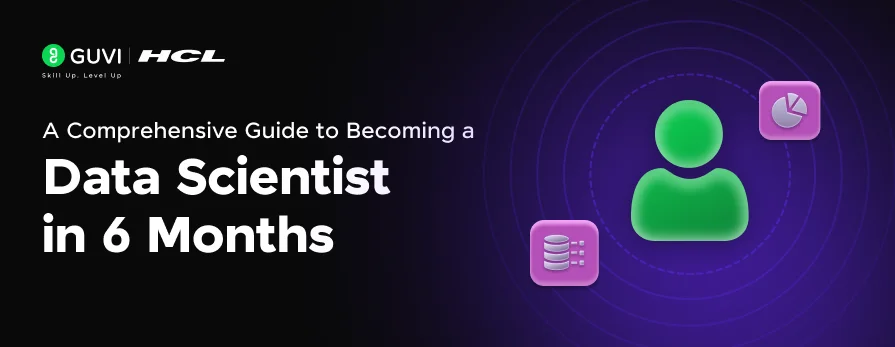
A Complete Guide to Becoming a Data Scientist in 6 Months
Jun 09, 2025 5 Min Read 10577 Views
(Last Updated)
At this point, there’s barely a soul out there that hasn’t heard the word ‘data science’, I mean it is THE tech career of the decade with amazing compensations and quality contributions at work!
The demand for data scientists has surged in recent years, as organizations increasingly rely on data-driven decision-making to gain a competitive edge. Data science is a field that combines expertise in statistics, computer science, and domain knowledge to extract valuable insights from vast amounts of data.
With the immense amount of information and all kinds of courses out there, becoming a data scientist is a hard task without proper guidance. Hence in this article, we will be learning about how you can become a data scientist in 6 months, with a timeline specifically for you. So, let’s get started.
Table of contents
- Introduction to Data Science
- Key Features of Data Science
- Applications of Data Science
- What Does a Data Scientist Do?
- Salary Insights in India
- Month-by-Month Learning Path for Becoming a Data Scientist
- Month 1: Building the Foundations
- Month 2: Data Handling and Exploration
- Month 3: Machine Learning Fundamentals
- Month 4: Advanced Machine Learning and Model Optimization
- Month 5: Specialization and Portfolio Building
- Month 6: Job Preparation and Application
- So what’s the takeaway here?
- FAQs
- Is data science hard?
- Can I become a data scientist in 6 months?
- Will data scientists still be in demand in 10 years?
- Will AI replace data science?
- Which stream is best for a data scientist?
Introduction to Data Science
Data science is an interdisciplinary field that combines statistical analysis, machine learning, data mining, and data visualization to extract meaningful insights from data. It involves the application of scientific methods to analyze large datasets and solve complex problems in various domains such as healthcare, finance, retail, and technology.
Key Features of Data Science
- Data Collection: Gathering structured and unstructured data from multiple sources such as databases, APIs, web scraping, and sensor data.
- Data Cleaning: Preparing raw data by handling missing values, correcting inconsistencies, and removing duplicates.
- Exploratory Data Analysis (EDA): Investigating datasets to summarize their main characteristics using statistical methods and visualization tools.
- Machine Learning: Developing algorithms that learn from data to make predictions or decisions without explicit programming.
- Big Data Technologies: Managing and processing large-scale data using distributed computing frameworks like Hadoop and Spark.

Applications of Data Science
- Healthcare: Predictive analytics for patient outcomes, disease progression, and personalized treatment plans.
- Finance: Credit scoring, fraud detection, algorithmic trading, and risk management.
- Retail: Demand forecasting, customer segmentation, and recommendation systems.
- Marketing: Sentiment analysis, targeted advertising, and churn prediction.
What Does a Data Scientist Do?
A data scientist’s role encompasses a broad spectrum of activities that require a combination of statistical expertise, programming skills, and business acumen. The primary responsibilities include:
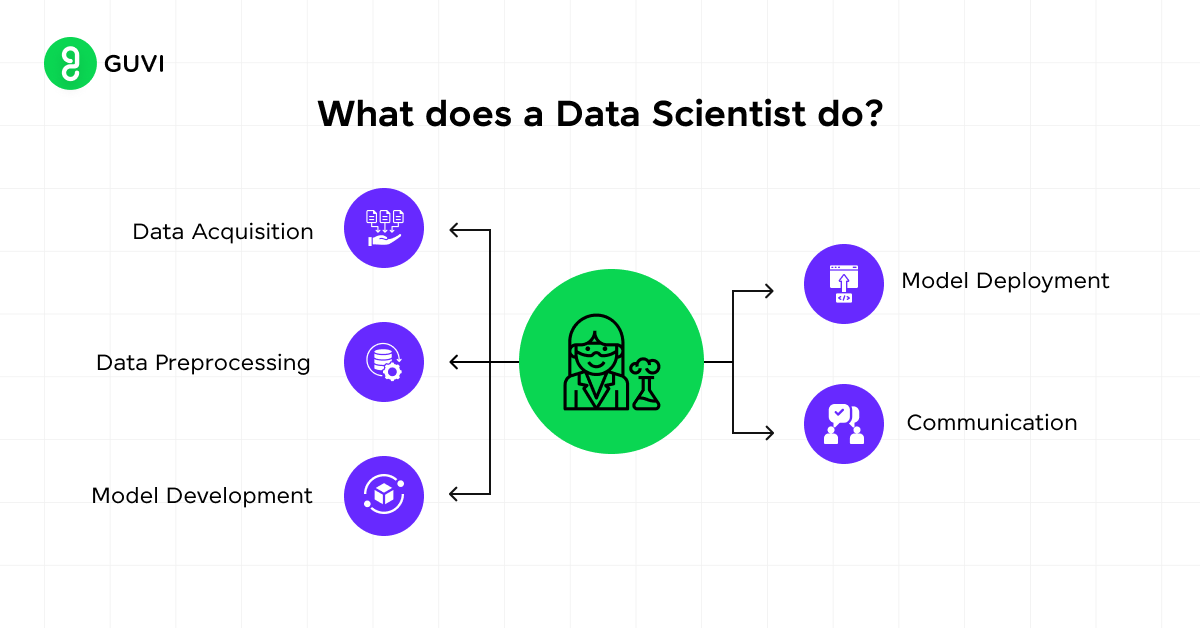
- Data Acquisition: Extracting relevant data from internal databases or external sources through APIs, web scraping, or direct access to databases.
- Data Preprocessing: Cleaning and transforming raw data into a usable format by handling missing values, normalizing data, and encoding categorical variables.
- Model Development: Building and validating machine learning models using algorithms such as decision trees, random forests, neural networks, and gradient boosting.
- Model Deployment: Integrating machine learning models into production environments, ensuring they are scalable and maintainable.
- Communication: Visualizing data and results through dashboards and reports, enabling stakeholders to make informed decisions.
Salary Insights in India
Data science is one of the most well-compensated fields in India. Here’s a detailed salary breakdown based on experience:
| Experience Level | Average Salary (INR) |
| Entry-Level (0-2 years) | 6-10 LPA |
| Mid-Level (2-5 years) | 12-20 LPA |
| Senior-Level (5+ years) | 25-40 LPA |
Note: Salaries vary widely based on location, industry, and individual expertise. The demand for data scientists in India is rising, especially in tech hubs like Bangalore, Hyderabad, and Pune.
Month-by-Month Learning Path for Becoming a Data Scientist
Month 1: Building the Foundations
This initial phase is crucial for establishing the core skills necessary for data science.
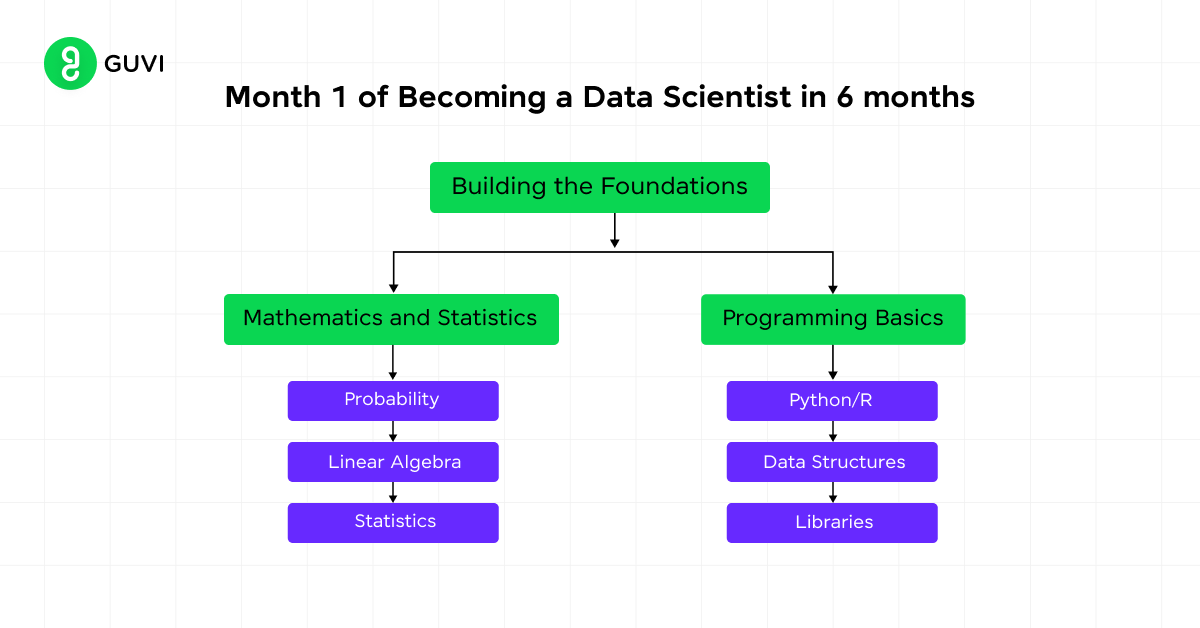
- Mathematics and Statistics:
- Probability: Learn concepts such as Bayes’ theorem, probability distributions (normal, binomial), and random variables. Understanding these is critical for both classical statistical methods and machine learning algorithms.
- Linear Algebra: Focus on matrix operations, eigenvalues, eigenvectors, and vector spaces. These are the building blocks for understanding data structures in machine learning, particularly in deep learning where tensors are used extensively.
- Statistics: Study descriptive statistics (mean, median, mode, standard deviation) and inferential statistics (hypothesis testing, confidence intervals, p-values). These concepts are foundational for making data-driven decisions and interpreting machine learning results.
- Programming Basics:
- Python/R: Begin with Python or R, the most widely used programming languages in data science. Python is favored for its extensive libraries (NumPy, Pandas, Matplotlib) and community support, while R is preferred for statistical analysis and data visualization.
- Data Structures: Learn about lists, dictionaries, sets, and data frames. Practice writing efficient code to manipulate data structures.
- Libraries: Start with NumPy (for numerical computations), Pandas (for data manipulation), and Matplotlib (for basic data visualization).
Month 2: Data Handling and Exploration
The second month should focus on data acquisition, cleaning, and exploratory data analysis.
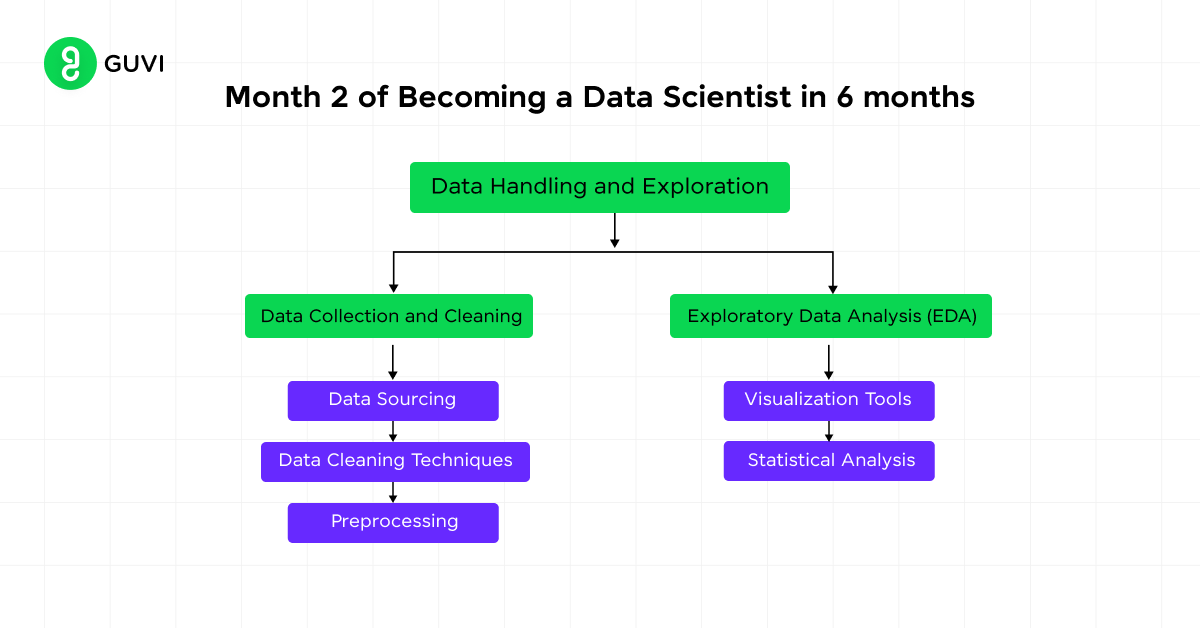
- Data Collection and Cleaning:
- Data Sourcing: Learn how to gather data from various sources like databases (SQL), APIs, web scraping tools (BeautifulSoup, Scrapy), and flat files (CSV, Excel).
- Data Cleaning Techniques: Address common data issues such as missing values (using techniques like mean/mode imputation, and forward fill), outliers (using IQR or Z-score), and inconsistent data types.
- Preprocessing: Understand data normalization, standardization, and encoding categorical variables (one-hot encoding, label encoding). These preprocessing steps are vital for ensuring data is in the right format for machine learning models.
- Exploratory Data Analysis (EDA):
- Visualization Tools: Use Matplotlib, Seaborn, and Plotly to create various plots (histograms, scatter plots, box plots) that help in understanding data distributions and relationships.
- Statistical Analysis: Perform univariate and bivariate analysis to understand the central tendency, dispersion, and correlation between variables. Use statistical tests (t-tests, chi-square tests) to identify significant patterns.
Does seem like quite the task, doesn’t it? Need proper guided help?
Then take a rightly paced approach with updated syllabi, tools, and industry-grade projects with GUVI’s Data Science Course brought to you by expert data scientists!
Month 3: Machine Learning Fundamentals
Now that you have a strong foundation, you can dive into machine learning.
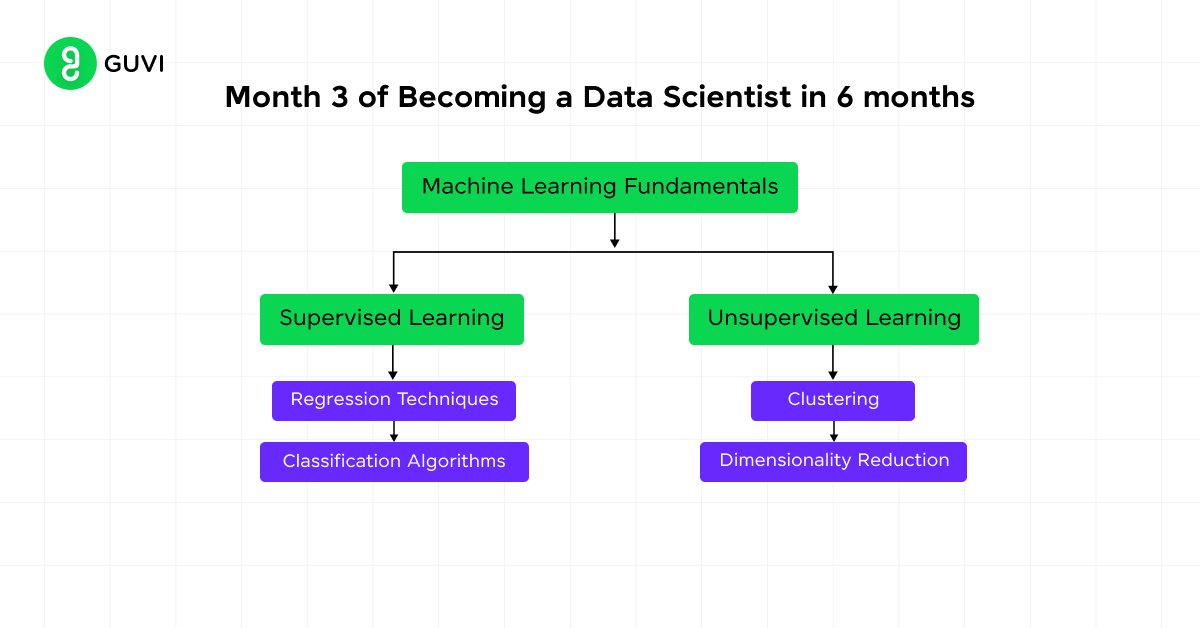
- Supervised Learning:
- Regression Techniques: Learn Linear Regression for predicting continuous variables and Logistic Regression for binary classification tasks. Understand concepts like cost functions, gradient descent, and regularization (L1, L2).
- Classification Algorithms: Explore Decision Trees, Random Forests, Support Vector Machines (SVM), and K-Nearest Neighbors (KNN). Each algorithm has its strengths; for example, SVM is powerful for high-dimensional spaces, while Random Forests are robust to overfitting.
- Unsupervised Learning:
- Clustering: Study K-Means Clustering, Hierarchical Clustering, and DBSCAN. These algorithms are used for grouping similar data points without predefined labels.
- Dimensionality Reduction: Learn about Principal Component Analysis (PCA) and t-Distributed Stochastic Neighbor Embedding (t-SNE) for reducing the dimensionality of data while preserving its structure.
- Projects:
- Start applying your knowledge by building simple projects. For instance, a house price prediction model using Linear Regression or an image classifier using SVM. Projects solidify your learning and provide practical experience.
Month 4: Advanced Machine Learning and Model Optimization
This month is dedicated to mastering more complex models and fine-tuning them.
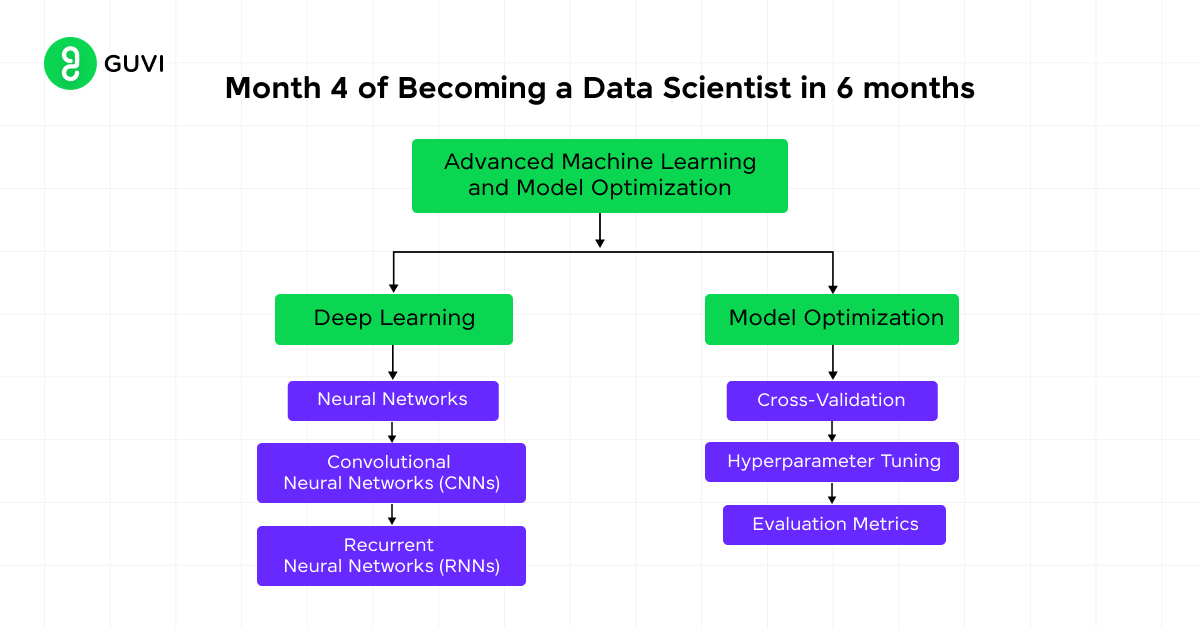
- Deep Learning:
- Neural Networks: Begin with the basics of artificial neural networks (ANNs), including perceptrons, activation functions (ReLU, Sigmoid), and backpropagation.
- Convolutional Neural Networks (CNNs): Learn about CNN architectures for image processing tasks. Key concepts include convolution layers, pooling layers, and dropout for regularization.
- Recurrent Neural Networks (RNNs): Study RNNs for sequential data, particularly in time series forecasting and natural language processing (NLP). Understand the challenges of vanishing gradients and explore solutions like Long Short-Term Memory (LSTM) networks.
- Model Optimization:
- Cross-Validation: Learn K-Fold cross-validation for evaluating model performance and avoiding overfitting.
- Hyperparameter Tuning: Explore grid search and random search for optimizing model parameters. Tools like Scikit-learn provide built-in functions for this.
- Evaluation Metrics: Dive into metrics beyond accuracy, such as precision, recall, F1-score, ROC-AUC, and confusion matrices. These metrics are crucial for assessing model performance, especially in imbalanced datasets.
- End-to-End Projects:
- Engage in a comprehensive project that involves data collection, model building, and deployment. For instance, you could create a recommendation system or an end-to-end NLP pipeline for sentiment analysis.
Month 5: Specialization and Portfolio Building
Focus on developing expertise in a specific area of data science and building a portfolio that showcases your skills.
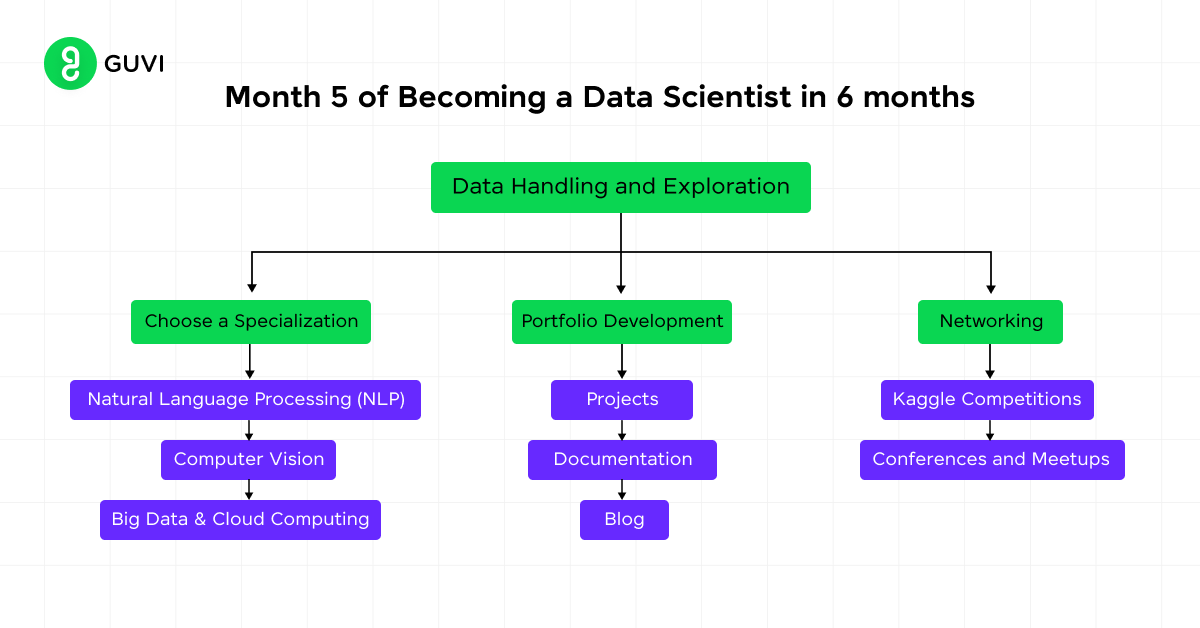
- Choose a Specialization:
- Natural Language Processing (NLP): Study text preprocessing techniques (tokenization, stemming, lemmatization), TF-IDF, and advanced topics like word embeddings (Word2Vec, GloVe), and transformers (BERT, GPT).
- Computer Vision: Learn about image preprocessing, data augmentation, and advanced CNN architectures like ResNet, VGG, and Inception. Explore object detection algorithms like YOLO and Faster R-CNN.
- Big Data & Cloud Computing: Understand the basics of big data tools (Hadoop, Spark) and cloud platforms (AWS, GCP) for deploying scalable data science solutions.
- Portfolio Development:
- Projects: Include diverse projects that demonstrate your expertise in different areas. Examples include an NLP project like sentiment analysis, a computer vision project like object detection, and a machine learning project like a predictive model for customer churn.
- Documentation: Create a GitHub repository for each project, including detailed README files, Jupyter notebooks, and any necessary scripts.
- Blog: Write technical blog posts explaining the projects and the techniques used. This not only showcases your knowledge but also helps you build a personal brand.
- Networking:
- Kaggle Competitions: Participate in Kaggle competitions to practice real-world problem-solving and gain recognition within the data science community.
- Conferences and Meetups: Attend data science conferences and local meetups to connect with professionals, learn from experts, and stay updated with the latest trends. Engaging in forums like Reddit’s r/datascience or attending webinars can also be beneficial.
Month 6: Job Preparation and Application
The final month is all about transitioning from learning to employment.
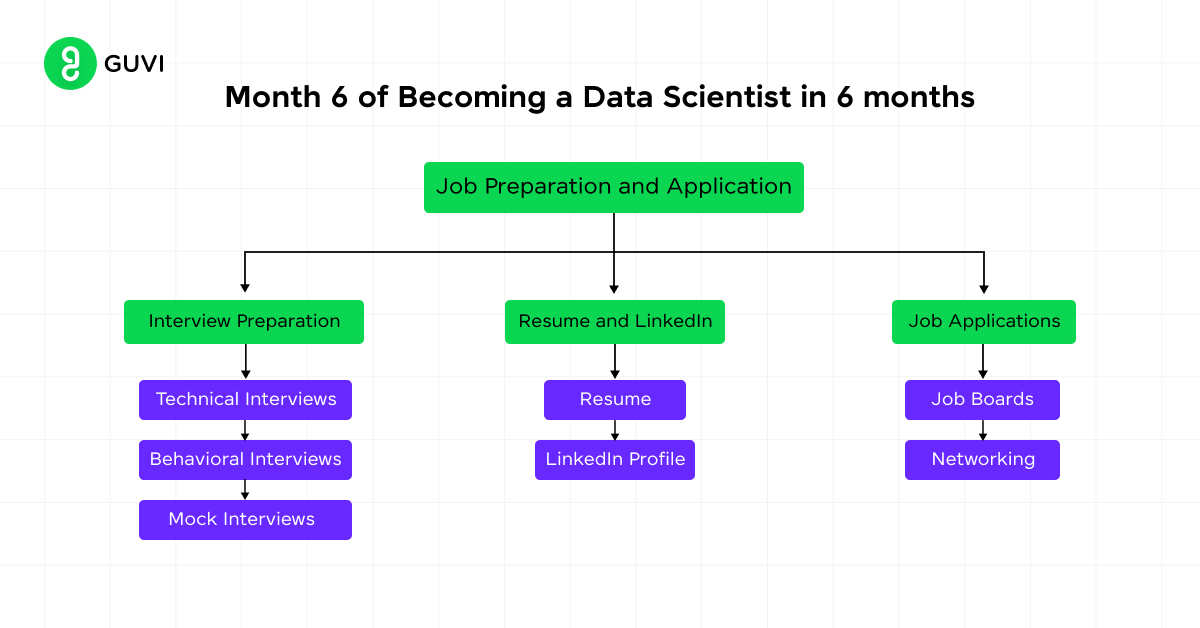
- Interview Preparation:
- Technical Interviews: Practice coding problems on platforms like LeetCode and HackerRank, focusing on data structures, algorithms, and SQL queries. Prepare for machine learning interviews by reviewing concepts like bias-variance tradeoff, regularization, and feature selection.
- Behavioral Interviews: Prepare for questions that assess your problem-solving approach, teamwork, and communication skills. Common questions might include scenarios where you handled large datasets or how you overcame challenges in a project.
- Mock Interviews: Consider participating in mock interviews with peers or mentors. This can help you get accustomed to the interview environment and receive feedback.
- Resume and LinkedIn:
- Resume: Tailor your resume to highlight your most relevant skills and projects. Focus on quantifiable achievements (e.g., “Improved model accuracy by 15% using advanced hyperparameter tuning techniques”).
- LinkedIn Profile: Ensure your LinkedIn profile is up-to-date with your latest skills, certifications, and projects. Use LinkedIn’s features like endorsements and recommendations to strengthen your profile.
- Job Applications:
- Job Boards: Start applying to data scientist positions through platforms like LinkedIn, Glassdoor, and Indeed. Tailor each application to the specific job description.
- Networking: Leverage your network by reaching out to contacts in the industry, attending job fairs, and connecting with recruiters.
So what’s the takeaway here?
Data science is certainly not for everyone, but for the interested and dedicated, it can be incredibly rewarding, while offering the chance to create a serious impact in today’s world.
You’re halfway there if you have the skill base to become a data scientist. Through this guide, I hope to have helped you begin your journey of mastering the right data science skillset, do let us know how you find it in the comments section below.
FAQs
Data science can be challenging due to its blend of statistics, programming, and domain knowledge, but with dedication and the right resources, it is achievable.
Yes, it’s possible but you will mostly be gaining foundational data science skills in 6 months, given that you strictly follow a roadmap curated for you such as the one given in this article.
Yes, data scientists are expected to remain in high demand as data continues to drive decision-making across industries.
AI will enhance data science but is unlikely to replace it entirely, as human expertise is crucial for interpreting and applying data-driven insights.
A background in computer science, statistics, mathematics, or engineering is ideal for a career in data science.





















![Top 9 Salesforce Developer Courses [2025] 10 salesforce developer course](https://www.guvi.in/blog/wp-content/uploads/2025/07/salesforce-developer-course.webp)


![How to Become a Web Developer Without a Degree: A Beginner's Guide [2025] 13 web developer without a degree](https://www.guvi.in/blog/wp-content/uploads/2025/05/How-to-Become-a-Web-Developer-Without-a-Degree.png)
![How to Become a Software Engineer Without a Degree? [2025 Guide] 14 Software Engineer without a degree](https://www.guvi.in/blog/wp-content/uploads/2025/05/How-to-Become-a-Software-Engineer-2.webp)
![How to Become a Systems Engineer: Expert Guide for Beginners [2025] 15 systems engineer](https://www.guvi.in/blog/wp-content/uploads/2025/05/How-to-Become-a-Systems-Engineer_-Expert-Guide-for-Beginners-1.png)
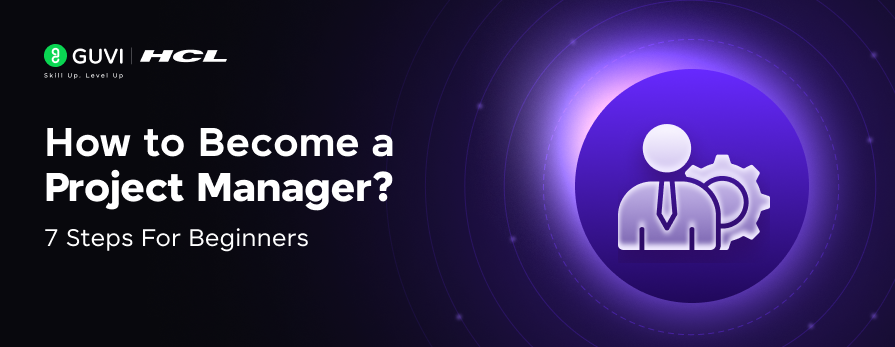



Did you enjoy this article?